
A savanna or savannah is a mixed woodland-grassland ecosystem characterised by the trees being sufficiently widely spaced so that the canopy does not close. The open canopy allows sufficient light to reach the ground to support an unbroken herbaceous layer consisting primarily of grasses. According to Britannica, there exists four savanna forms; savanna woodland where trees and shrubs form a light canopy, tree savanna with scattered trees and shrubs, shrub savanna with distributed shrubs, and grass savanna where trees and shrubs are mostly nonexistent.

Thespesia populnea, commonly known as the portia tree, Pacific rosewood, Indian tulip tree, or milo, among other names, is a species of flowering plant belonging to the mallow family, Malvaceae. It is a tree found commonly on coasts around the world. Although it is confirmed to be native only to the Old World tropics, other authorities consider it to have a wider, possibly pantropical native distribution. It is thought to be an invasive species in Florida and Brazil.

Spathodea is a genus in the plant family Bignoniaceae. The single species it contains, Spathodea campanulata, is commonly known as the African tulip tree. The tree grows between 7–25 m (23–82 ft) tall and is native to tropical dry forests of Africa. It has been nominated as among 100 of the "World's Worst" invaders.

Panicum (panicgrass) is a large genus of about 450 species of Poaceae grasses native throughout the tropical regions of the world, with a few species extending into the northern temperate zone. They are often large, annual or perennial grasses, growing to 1–3 m (3–10 ft) tall.
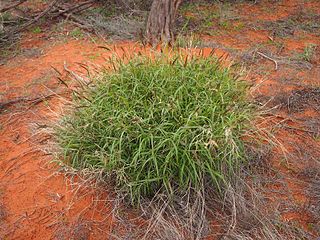
Cenchrus ciliaris is a species of grass native to most of Africa, southern Asia, southern Iran, and the extreme south of Europe (Sicily). Other names by which this grass is known include dhaman grass, anjan grass, koluk katai and buffelgrass.

Miconia crenata, commonly called soapbush, clidemia or Koster's curse, is a perennial shrub. It is an invasive plant species in many tropical regions of the world, causing serious damage.
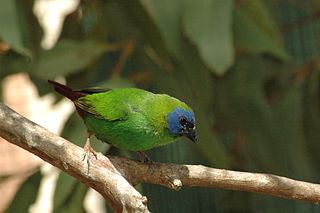
The blue-faced parrotfinch is a locally common species of estrildid finch found in north-eastern Australia, Japan, Indonesia, Federated States of Micronesia, France (introduced), New Caledonia, Palau, Papua New Guinea, the Solomon Islands and Vanuatu. It has an estimated global extent of occurrence of 10,000,000 km2.

Hawaiian Electric Industries, Inc. (HEI) is the largest supplier of electricity in the U.S. state of Hawaii, supplying power to 95% of Hawaii's population through its electric utilities: Hawaiian Electric Company serving Oahu, Hawai'i Electric Light Company serving The Big Island, and Maui Electric Company serving Maui, Lanai and Molakai. In addition, HEI owns a financial institution serving Hawaii, American Savings Bank, and a clean energy and sustainability company, Pacific Current LLC.
Wildfires consume live and dead fuels, destabilize physical and ecological landscapes, and impact human social and economic systems. Post-fire seeding was initially used to stabilize soils. More recently it is being used to recover post wildfire plant species, manage invasive non-native plant populations and establish valued vegetation compositions.

Panicum decompositum, known by the common names native millet, native panic, Australian millet, papa grass, and umbrella grass, is a species of perennial grass native to the inland of Australia. It occurs in every mainland state. The seeds can be cultivated to produce flour typically used in Aboriginal bushfood. The species is also considered to have relatively high palatability by livestock, making it suitable for grazing pastures.
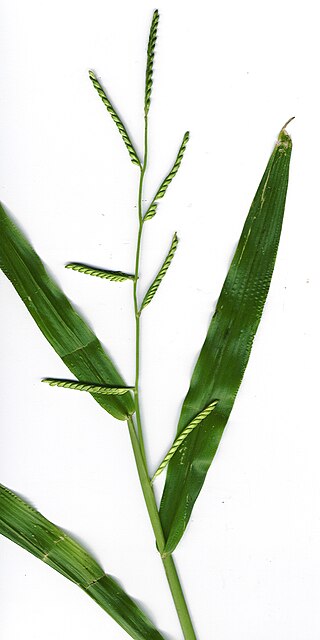
Brachiaria, or signalgrass, is a genus of plants in the grass family native to tropical and subtropical regions of Asia, Africa, Australia, southern Europe, the Americas, and various islands. There are over 100 species.
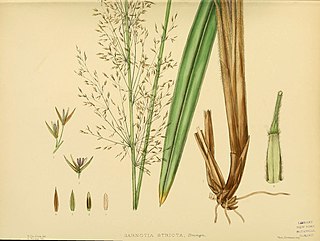
Garnotia is a genus of Asian, Australian, and tropical island plants in the grass family. Several of the species are native to Sri Lanka and southern India.

Isachne is a widespread genus of tropical and subtropical plants in the grass family, found in Asia, Africa, Australia, the Americas, and various oceanic islands. They may be known generally as bloodgrasses.

Panicum effusum, commonly known as hairy panic, is a grass native to inland Australia. It occurs in every mainland state, as well as New Guinea. In dry conditions, the fast-growing grass can become a tumbleweed.
Bela "Bert" Grof was a Hungarian-born Australian agricultural researcher with contributions to grassland and forage research in the tropics.

Andropogon gayanus. commonly known as gamba grass, Rhodesian blue grass, tambuki grass, and other names, is a species of grass native to most of the tropical and subtropical savannas of Africa.

Panicum repens is a species of grass known by many common names, including torpedo grass, creeping panic, panic rampant, couch panicum, wainaku grass, quack grass, dog-tooth grass, and bullet grass. Its exact native range is obscure. Sources suggest that the grass is native to "Africa and/or Asia", "Europe or Australia", "Eurasia", "Australia", "Europe, Asia, and Africa", or other specific regions, including the Mediterranean, Israel, and Argentina. It is present in many places as an introduced species and often a noxious weed. It has been called "one of the world's worst weeds."
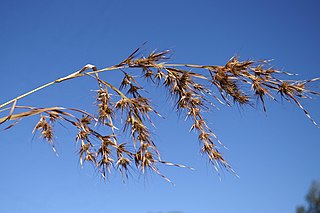
Themeda quadrivalvis is a species of grass known by the common names grader grass, habana grass, and kangaroo grass, not to be confused with Themeda triandra, which is also known as kangaroo grass. It is native to India, Nepal, and Malaysia. It can also be found in many other places as an introduced species and often a noxious weed. It occurs in the United States, New Caledonia, Fiji, Mauritius, Thailand, Indonesia, Papua New Guinea, China, the Middle East and tropical America. It is a troublesome exotic weed in Australia, especially in northern regions. It is also an agricultural weed in crops such as sugar cane and lucerne.

Bothriochloa pertusa is a species of grass. It is widely used as a fodder and a graze for livestock.
Sri Lanka exhibits a remarkable biological diversity and is considered to be the richest country in Asia in terms of species concentration.

















